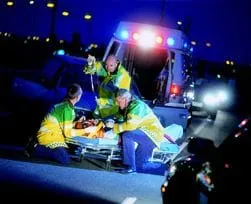Whiplash
The tragic result of uncorrected trauma.
Collisions that occur during sporting events, slips, falls or automobile crashes can all have a damaging effect on your neck and back. These types of collision-related injuries are often called a "whiplash."
The resulting instability of the spine and soft tissues can contribute to headaches, dizziness, blurred vision, pain in the shoulders, arms and hands, reduced ability to turn and bend, and low back problems. As the body attempts to adapt, symptoms may not appear until weeks or even months later.

Consult a Doctor of Chiropractic before depending upon addictive pain medication, enduring constant whiplash-related headaches or submitting to surgery.
Most auto-related whiplash injuries occur when a car is stopped and occupants are unaware that they are about to be hit from the side or from behind.
Occupants often suffer more than the car.
Whiplash is most commonly received from riding in a car that is struck from behind or that collides with another object. When the head is suddenly jerked back and forth beyond its normal limits, the muscles and ligaments supporting the head and spine can be stretched or torn. The soft, pulpy discs between spinal bones can bulge, tear, or rupture. Vertebrae can be forced out of their normal position, reducing range of motion.
- Bocchi, L., Orso, T., Whiplash Injuries of the Cervical Spine, Southern Italy ORTHOP, Traumatal Supplement, 171-181, November 9, 1983.
- Burn, L., A Manual of Medical Manipulation, Kluwer Academic Publishers, 1994.
- Calliet, R., M.D., Neck and Arm Pain, F.A. Davis Company, 1977.
- Coffee, M.S., Edwards, W. T., Hayes, W. C., and White, Hyperextension Injury Patterns in the Human Cadaveric Cervical Spine, Cervical Spine Research Society, 1989.
- Farbmann, A. A., Neck Sprain, JAMA, 223(9): 1010-1015, 1973.
- Forman, S., D.C., Croft, A., D.C., Whiplash Injuries: The Cervical Acceleration/Deceleration Syndrome, Williams and Wilkins, 1995.
- Gay, J., M.D., Abbott, K., M.D., Common Whiplash Injuries of the Neck, JAMA, p. 1698-1704, August 29, 1953.
- Green, J. D., Harle, T. S., Harris, J. H., Jr., Anterior Subluxation of the Cervical Spine: Hyperflexion Sprain, AJNR 2:243-250, 1981.
- Liberti, F., D. C., Can A Passenger Be Injured If The Car Is Not? Medical/Legal Consultants Associates, 1994.
- MacNab, I., Acceleration Extension Injuries of the Cervical Spine, Editors: Rothman, M.D., Simone, M.D., the Spine, 2nd edition, Vol. 2, W.B. Saunders, Philadelphia, 1982.
- Torola, G.A., Whiplash: General Considerations, Assessment, Treatment, Management and Prognosis, Part 1, ACA Journal of Chiropractic, 30(1): 63-70, 1993.
- White, A. A., M.D. and Panjabi, M. M., PhD., Clinical Biomechanics of the Spine, 2nd edition, J.B. Lippincott, 1990.
- Yochum, T., D.C., D.A.C.B.R., Rowe, T., D.C., D.A.C.B.R., Essentials of Skeletal Radiology, Vol. 1, Williams and Wilkins, 1987.

